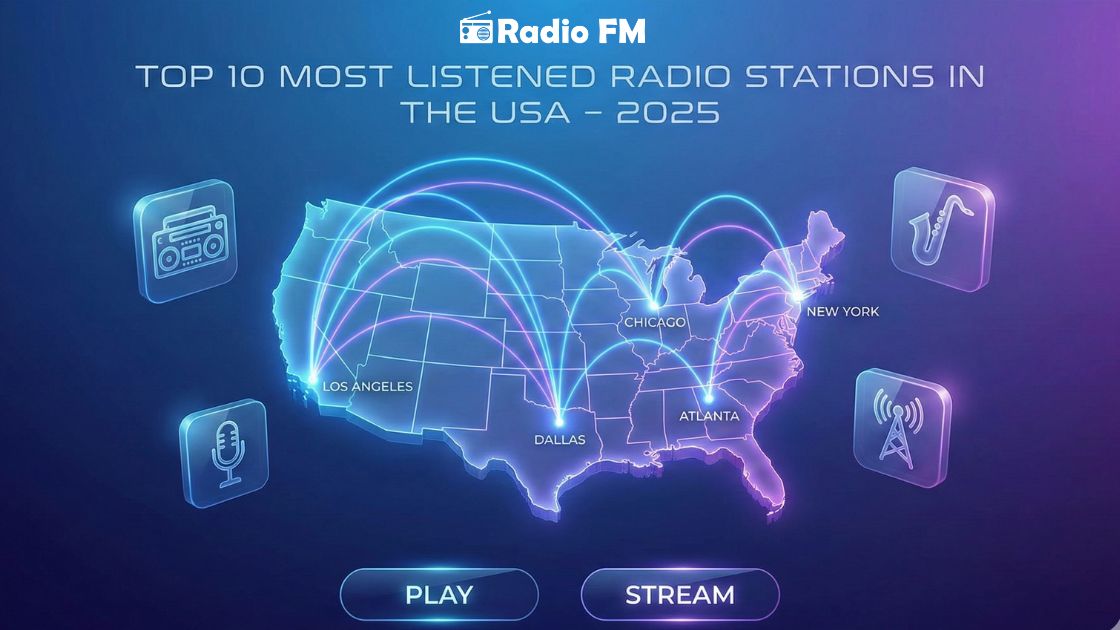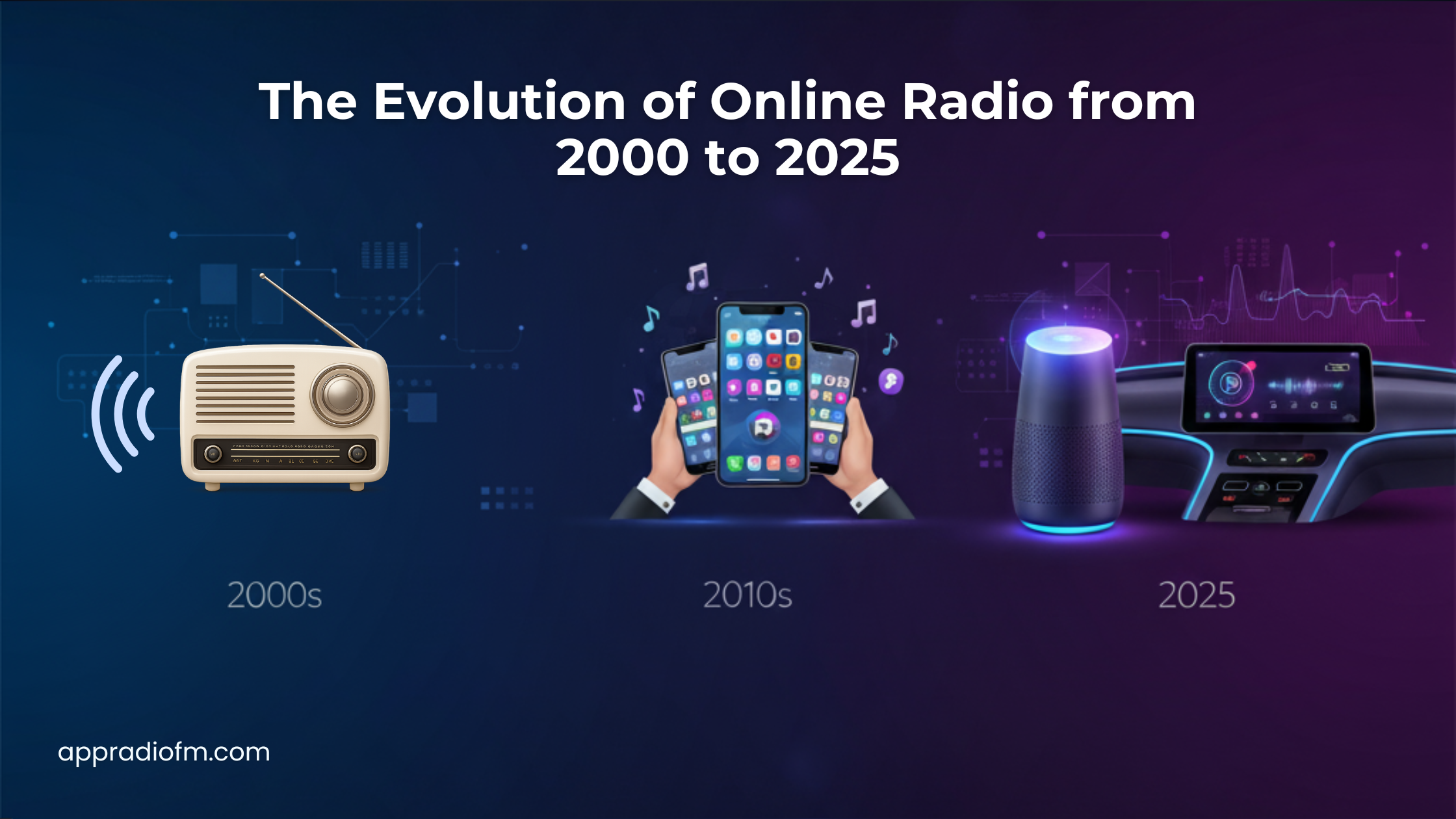.png)
The Evolution of Online Radio: From 2000 to 2025
The Evolution of Online Radio from 2000 to 2025
Introduction
Music and radio are part and parcel of our lives. Earlier, it would be compulsory to be dependent on only FM/AM channels in order to hear songs, news and programs. The internet revolution reversed the trend. From the very early 2000s till the present time in the year 2025, online radio has emerged as a force to reckon with in digital entertainment.
This blog post will describe the history of internet radio — where it originated, how it progressed with advancing technology, and where it will be in the coming years.
Online Radio in the Earlier 2000s
Online radio history begins in the early 2000s. The internet connections then were slow, and it wasn't easy to stream audio. However, enthusiastic music lovers began to experiment with software such as Winamp and Shoutcast to establish minuscule web radio stations.
They had low sound qualities and tended to be static because of the slow internet. Nevertheless, it was exciting in the sense that, for the very first time, a listener in one nation could hear a song in another nation. Old-fashioned FM radio never had the capacity to do so.
It is true that online radio had been niche for quite some time, but this was only the beginning.
Growth in the 2010s: From Small to Mainstream
As Internet speeds have been increasing faster and smartphone usage has started becoming mainstream, internet radio has become a part of our daily lives in the form of apps and has been growing on a real-time basis in the 2010s in real terms.
Popular apps such as RadioFM, TuneIn, and iHeartRadio simplified the process of searching through thousands of digital radio stations. Users could now look by country, genre, or language. Overnight, individuals now had an infinite amount of choices versus having limited local FM channels.
This was the same decade in which podcasts went big. Most online radio services began to stream podcasts in addition to their real-time stations. For the very first time, subscribers could listen to real-time programs or select on-demand programs. At the end of the 2010s, online radio ceased to be an amateurish experiment — it had reached mainstream listening.
Online Radio in 2025: A Universal Experience
Today, in 2025, online radio is more powerful and accessible than ever. Thanks to high-speed 5G internet and smart devices, listening is smooth and personalized.
Some of the reasons why online radio is prevalent today are:
Global coverage – More than 100,000 worldwide station coverage.
Personalized recommendations – The AI recommends stations and podcasts based on what is enjoyed.
Device support – You can hear the radio on Alexa, Google Home, or in a car on an Android Auto or Apple CarPlay.
Format diversity – The apps provide radio + podcasts + playlists combination, with higher choice compared to FM.
Internet radio is worldwide whereas ordinary FM is limited only within the premise of an individual station. For instance, an individual in India will be able to listen to a Latin American station in Brazil or to a New Orleans station carrying jazz in seconds.
Online Radio versus FM Radio
Even in 2025, FM radio is still alive, and present in automobiles and countryside space. However, online radio has obvious benefits:
- FM radio is local but online radio is global.
- FM has limited options, whereas online radio has millions of programs and tunes.
- FM is internet-agnostic but shortfalls in the areas of intelligence and personalization.
This is why radio streams on the internet are gaining popularity by the year.
Advantages of Internet Radios
Online radio growth is not merely a technology story. It has real benefits to listeners as well: Limitless choice – Music, programs, sports, breaking news, podcasts, and anything in between.
- Global accessibility – Listen to radio anywhere in the globe.
- Personal experience – AI recommendations show you and suggest tv programs and music.
- On-demand choices – Recordings and podcasts may be listened to at any time.
- Accessibility – It is available on phones, laptops, automobiles, and intelligent speakers.
These are the reasons why online radio attracts the young and the old.
Challenges Confronting Internet Radio
Internet radio evolution wasn't always smooth either. Some of the typical issues were:
- Sluggish internet speeds on the first few days.
- Copyright and licensing problems, as some of these stations broadcast with no license.
- Ads and money issues — free services very much depended on advertisements.
- Competition by music apps such as Spotify and YouTube.
Despite all these problems, online radio has managed to endure thanks to how it is versatile and universally popular.
Beyond 2025: Internet Radio in the Future
What will online radio be like after 2025? Experts say it will be even more advanced and customized. The following are some likely trends:
- AI Disc Jockeys that create mixes and even chat up listeners.
- Personalized playlists of real-time radio broadcasts, podcasts, and recent tunes.
- Live performances and events streamed on radio apps.
- Interactive features by which listeners vote or ask on-air in real time.
As the technology advances even more, online radio will no longer be merely an audio provider but an immersive experience.
Final Thoughts:-
Online radio has seen a remarkable journey from small experiments in the early 2000s to AI-powered global platforms in 2025. There has been a remarkable evolution of online radio during the last few decades.
It is evident that technology can enable the transformation of something as old as radio into a powerful digital tool for entertainment that is modern, global, and accessible. Internet radio today offers more choices, control, and accessibility than ever before. And with new technology on the agenda the online radio scene is rosier than ever.



